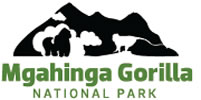Mgahinga Gorilla National Park Uganda’s smallest park features the most breathtaking landscape. This park lies in the Virunga Massif area, encompassing 3 inactive volcanoes – Mount Gahinga, Muhabura and Sabyinyo volcanoes. These landforms are typical land formation of volcanic eruption along the rift valley area.
Considering the presence of the Virunga Volcanoes, Mgahinga National Park is without doubt the best place to visit for volcanic hiking. A hike to the peak of Sabyinyo involves conquering the steep/rugged slopes and you will spend about 8 hours. This volcano rises at altitude of 3669 meters, Gahinga Volcano 3474 meters and Muhabura Volcano 4127m.
Geography of Mgahinga Park in Uganda
Mgahinga Park is geographically situated in the far Southwestern Uganda. Near to this spectacular protected area are other beautiful tourist sites including Lake Mutanda, Bwindi Impenetrable National Park, Lake Bunyonyi, Virunga National Park and Volcanoes National Park. It was established in 1991 the same year when Bwindi Impenetrable Forest Park was gazetted.
The park spans on 33.7 sq km of land area, rising high at an altitude of 2227 to 4127m. It forms part of the River Nile watershed area with its boundaries spanning towards the Virunga NP Congo and Rwanda Volcanoes N/Park. If you are in Kisoro, you can drive for 15 km to Mgahinga NP and from Kabale, the park is 55 km.
The Virunga Volcanoes
Mgahinga Gorilla National Park has three volcanoes, which are part of the Virunga volcanic range in East Central Africa, expanding to the Albertine Rift on the Rwanda, DRC and Uganda border, north and north east of Lake Kivu. The three volcanoes in Mgahinga Gorilla National Park are thought to have arisen in the early to mid-Pleistocene era, and to have formed through a deposition of layers of ash and cinders from successive lava flows. Sabyinyo is believed to be the oldest volcano, followed by Gahinga, which is younger, and with a swamp crater of about 180m diameter at the summit. Muhabura is believed to be the youngest volcano. It is cone-shaped with a small crater lake approximately 36m in diameter at its summit. There are numerous caves on the slopes of the mountains, caused by lava tubes.
Because of its protective vegetation cover, Mgahinga Gorilla National Park is an important water catchment area. Apart from the numerous streams flowing northwards from the mountains, there is a crater lake on Mt Muhabura and a swamp crater on Mt Gahinga summit. There are also swamps in the saddles between the three volcanoes that retain water all year round, while the plains at the foot of the volcanoes are characterised by deep volcanic ash, and run-off from the mountains rapidly disappears underground.
